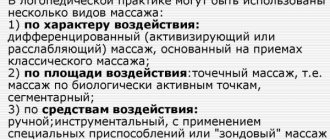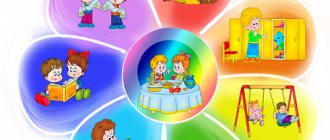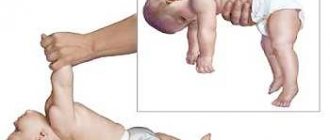Massage of a child with tone: video
In medicine, there is the concept of muscle tone, which consists of small muscle tension present in a state of relaxation and calm.
When there is an impact from the outside, the muscles relax and tense. One of the reasons for such symptoms is mainly increased muscle tone in children, which manifests itself as a result of certain abnormalities. This increased tone is also called hypertonicity in medicine. The main method of treatment and prevention is massage of the child with tone .
When a child is born, he generally experiences an increase in tone. These are purely physiological signs that are associated with the fact that the baby has been in the mother’s tummy for a long time. While the baby is in the womb, his arms, legs, and chin are pressed tightly to the body. In this state, the fetal muscles are quite tense. And this happens throughout pregnancy.
When a child is born, it is necessary to carefully monitor the tone of his muscles. This is done from the first days of a newborn’s life. Right now you can notice all the anomalies that arise quite clearly. If measures are not taken in a timely manner, the result is that gait and alignment are impaired, and the child lags behind in the development of movements. Thus, the primary task of parents is to systematically observe and record all children's postures and movements. And you don’t have to wait until it’s time to visit a doctor. Muscle tone in children, its indicator is not only the basis of various movements. This indicator reflects the holistic condition of the child, as well as his nervous system.
With hypertonicity, the child experiences frequent hysterics, is restless, and has disturbed sleep. Every sound and bright lighting has an irritating effect on him. Since the occipital muscles are tense, the child holds his head well even at birth. The baby's legs and arms are constantly tightening, as if he is trying to bring them together. And when you want to separate them, there is a feeling of resistance. To accurately determine the pathology associated with the nerves, you should once again spread the baby’s legs. If he resists strongly, therefore, there is muscle hypertonicity. Also, a distinctive feature of hypertonicity is pressing the fingers and the desire to rise on the tiptoes. All this affects the baby’s spine and gait in the future. It is quite common to observe tense neck muscles, resulting in tension in the head and back. As a result, the brain structures are very active, intracranial pressure increases, and the child is very excited. Until six months, hypertonicity is not dangerous, it’s just physiology.
Hypertonicity is mainly noticed in the baby’s legs and arms. To check the tone in the legs, the child is taken under the arms and placed on his feet, slightly tilted forward. The baby must be placed on a flat surface. The child begins to stomp like an adult. If there is tone, the baby stands on tiptoes.

If there is tone in the hips, then when spreading the legs to the sides, strong resistance is felt. If the child is healthy, then there is no reaction from him to such actions; he freely allows all this to be done. If such signs persist even after six months, it is recommended to contact a neurologist and pediatrician.
Massage for a child for muscle tone
To get rid of the manifestations of increased muscle tone, you need to do a special massage that relaxes the muscle tissue.
The environment should be comfortable:
- Ventilated room;
- Massage table;
- Clean hands;
- The procedure is performed after eating 40 minutes;
- It is advisable to use powder or cream;
- The child should be in a calm state;
- The massage is done for five minutes, and after three months it increases to ten minutes.
The massage technique includes muscle relaxation.
Main techniques in massage:
- Stroking movements to relieve tension and improve blood circulation.
- Hand massage is performed alternately.
- Foot massage is performed while lying down, as the legs rise and fall.
There are also certain techniques that massage therapists perform. Using them, increased muscle tone is relieved and pathologies do not develop.
Muscle hypertonicity in children under one year of age: symptoms, consequences and treatment, massage for hypertonicity
Hypertonicity is a violation of the muscle tone of the body, which is expressed in muscle overstrain. Almost all babies are born with severe muscle hypertonicity. After all, while inside the womb, the baby is constantly in the fetal position. The limbs and chin in this position are pressed closely to the body and the muscles of the fetus are constantly tense.
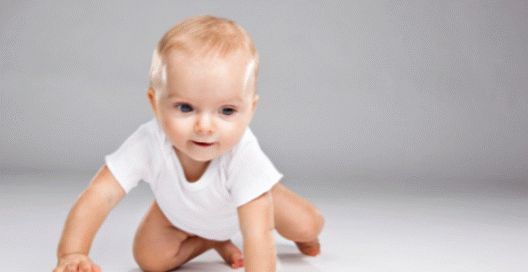
hypertension in children under one year old
Until about six months, the baby’s nervous system “learns” to work in conditions different from those in the womb. The baby gradually develops and slowly begins to control the movements of his muscles and skeleton. In a one-month-old baby, hypertonicity is very pronounced. This is reflected in clenched fists and bent legs, and in throwing the head back. The tone of the extensor muscles in a one-month-old baby is higher than the flexor muscles.
With physiological hypertonicity, the child’s legs move apart only 45 0 each. When moving your legs away, you feel a pronounced resistance to movement. By three months, muscle hypertonicity in a child without pathologies practically disappears. If muscle tension persists after your child reaches six months, you should immediately consult a doctor.
Symptoms of hypertension
Video:
Complications during pregnancy, birth injuries, Rh conflict, incompatibility of the blood of parents, residence in a poor environmental situation and many other factors will cause hypertension. It is worth paying close attention to the symptoms of hypertonicity, because this can be an expression of a serious neurological disease.
Signs of severe hypertension:
- Restless and short sleep.
- In the lying position, the head is thrown back, and the arms and legs are tucked.
- When trying to separate the baby's legs or arms, strong resistance is felt. The child cries at the same time. Secondary dilution increases muscle resistance.
- Vertically on a hard surface, the child tries to stand on the front part of the foot, that is, stands on tiptoes (Information: if the child walks on tiptoes).
- When crying, the child throws his head back, arches, and at the same time his chin muscles tremble (See the article on chin tremor).
- Frequent regurgitation.
- Painful reaction to various stimuli: light, sound.
- From birth, the baby “holds” his head due to constant tension in the neck muscles.
Treatment
Correct and timely treatment of hypertension is carried out exclusively by a specialist doctor - a pediatric neurologist. All procedures are prescribed only by the attending physician. The sooner you start treatment, the better and faster the positive results will appear.
There are several techniques and directions in medicine that allow you to relieve hypertension:
- Relaxing massage.
- Physiotherapy.
- Electrophoresis.
- Paraffin applications (heat therapy).
- Swimming.
- Drug treatment.
As can be seen from the list, to remove hypertension, medications are used last. These are drugs that relax muscles, reduce muscle tone and diuretics to reduce brain fluid levels. In addition to the massage, dibazole and B vitamins may be prescribed.
Massage
Massage for hypertonicity can be done independently at home starting from two weeks of age. Naturally, you first need to consult with a specialist in children's massage and get instructions and recommendations for massage from him. A total of ten sessions are carried out, which are best repeated again after six months.
The massage consists of three types of influence techniques: stroking, rubbing and rocking:
- With the back of your hand we stroke the surface of your arms, legs and back. You can alternate superficial stroking with your fingers with grasping stroking with the whole brush.
- Circular rubbing of the skin. The baby is placed on his tummy and rubbed in a circular motion with his fingers using stroke movements from bottom to top. Then the same is done with the limbs, turning the child onto his back.
- Take the baby's hand and shake it slightly. In this case, you should definitely hold your hand in the forearm area. Carry out the procedure with both arms and legs.
- Take the baby by the arms above the wrist and rhythmically swing his arms in different directions.
- Grab the child's legs by the shins and rock them.
- Finish the massage by gently stroking your arms and legs.
If you have hypertonicity, you should not use deep muscle kneading, patting or chopping techniques. All movements should be smooth and relaxing, but rhythmic.
Video: how to massage for hypertonicity
Baths
An excellent remedy for relieving hypertension are herbal baths. Water itself has a relaxing property, and in combination with herbs it becomes an excellent remedy for hypertension. Take turns for four days to take warm baths with valerian root, lingonberry leaf, motherwort and sage. A break is taken for one day, the procedures are repeated again, and so on for 10 days. Pine baths also have an excellent relaxing effect.
Massage for hypertension in adults
Massage for hypertonic legs is aimed at maximizing muscle relaxation. For this purpose, special cushions are placed under the knees and ankles. The massage procedure begins with general stroking of the limbs. The session begins with working on stretched muscles, then treating muscles with increased tone. Extensors - muscles with increased tone, are massaged using relaxing techniques. Apply superficial rubbing and stroking, deep kneading. Stretched flexor muscles are atrophied, so they are massaged more intensely. If massage for hypertonicity is well tolerated, the technique may include felting and deep kneading techniques. But striking techniques are excluded. The back and neck can also accumulate residual stresses, which contribute to the further development of osteochondrosis. Massage for hypertonicity of the back and neck helps: • relieve pain; • restore blood flow; • enhance brain activity; • increase potency; • restore sleep, strengthen the nervous system.
How to properly massage for toned legs in children?
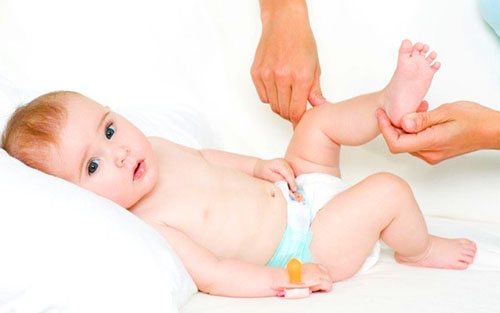
Every young mother needs to learn how to do a massage to tone the legs of children. For nine months the baby is in a woman’s womb in an awkward position. At this time, his still not fully formed muscles experience overstrain. Therefore, after birth, infants most often experience increased muscle tone. Massage will help cope with this problem. The main thing is to remember a few basic rules for the procedure.
Symptoms of increased leg tone
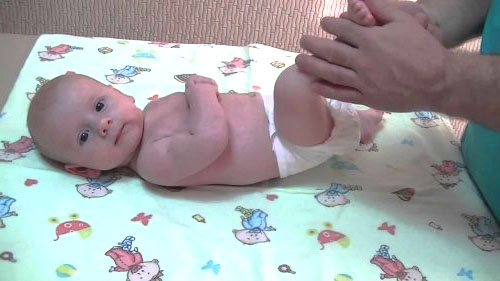
For an accurate diagnosis, consult your pediatrician. It is not difficult to recognize hypertension at an early age. Every mother can do this based on visual signs. There are several main symptoms:
- Strong crying and constant restlessness of the baby.
- Lack of restful sleep. Each time the child tries to assume the fetal position. Cries often.
- After each feeding the baby spits up.
- The baby constantly tightens his legs.
- A sharp reaction to any sounds or bright light.
- When you try to move your legs to the side, you feel significant resistance.
If symptoms are detected, you should immediately begin a course of massage to tone the legs in children.
If you are not sure that you have correctly identified your baby's condition, consult your pediatrician.
Hypertension must be treated. It not only causes suffering to the baby, but also inhibits the development of his musculoskeletal system. Children with this diagnosis begin to crawl and walk much later than their peers.
Massage for hypertonic legs in infants: conditions, technique, movements
In general, any tone is the minimum necessary muscle tension in a calm state.
Since in the womb the child is in a compressed and tense position for 9 months, that is, almost a year, by the 10th month, after birth, the tension does not disappear anywhere for several more months, this is especially noticeable in the compressed position of the legs.
In order to quickly bring the muscular skeleton to a state of normal tone, infants need special therapy, for which you need to know how to massage the legs of a child.
Preparation for the procedure
Characteristic symptoms of hypertension:
- When lifting a child by the armpits, his legs may cross, and when lowering the newborn onto a hard surface, only the toes will touch it, and not the entire foot.
- Crying for no apparent reason, blue nails or lips, twitching of the chin.
- Frequent tilting of the head back.
- Constantly clenching the palm into a fist with the thumbs inside.
- Periodic intense regurgitation.
- Short and restless sleep.
- During sleep, the limbs are bent. When trying to straighten the child's limbs to the sides, the child will begin to resist and be capricious.
The procedure can be performed at home, but only after the recommendations of a pediatrician. You should take care in advance about comfort during the process. The room temperature should not be lower than 25°C.
Before the treatment, the room should be ventilated and wet cleaned if the humidity in the room is insufficient for a comfortable stay.
The procedure is carried out no earlier than 40 minutes after feeding.
The massage therapist's hands should be warm, dry and with short-cut nails. During the process, you can use baby oil or cream for greater comfort.
Symptoms of increased leg tone
For an accurate diagnosis, consult your pediatrician. It is not difficult to recognize hypertension at an early age. Every mother can do this based on visual signs. There are several main symptoms:
- Strong crying and constant restlessness of the baby.
- Lack of restful sleep. Each time the child tries to assume the fetal position. Cries often.
- After each feeding the baby spits up.
- The baby constantly tightens his legs.
- A sharp reaction to any sounds or bright light.
- When you try to move your legs to the side, you feel significant resistance.
If symptoms are detected, you should immediately begin a course of massage to tone the legs in children.
If you are not sure that you have correctly identified your baby's condition, consult your pediatrician.
Hypertension must be treated. It not only causes suffering to the baby, but also inhibits the development of his musculoskeletal system. Children with this diagnosis begin to crawl and walk much later than their peers.
Where to start the exercises?
Almost all newborns, at the first opportunity, bend their legs to their tummy, keep their arms pressed to their chest, and clench their fists.
But normally, the tension should not be too strong, and when trying to unclench the fist or straighten the arms and legs, the mother should not feel any noticeable resistance. These are signs of physiological hypertonicity.
This is a normal condition for a baby, and by the age of six months the baby’s muscle tone should return to normal. In this case, a daily massage performed by mom, dad or another relative will be enough.
If, when opening a small fist, an adult feels noticeable resistance, this is a reason to seek advice from a specialist. Only a doctor can accurately identify pathological hypertonicity in a child. Pathological muscle hypertonicity can slow down the rate of physical development, as it interferes with the correct formation of motor skills.
There is a high probability that over time the child may develop orthopedic problems such as gait and posture disorders. In some cases, increased muscle tone is a symptom of serious neurological pathologies, for example, metabolic diseases, disorders of brain development, cerebral palsy (CP) and others.
Pathological hypertonicity can be caused by:
- severe toxicosis in the mother in the first trimester of pregnancy (during this period all organs and systems of the child are formed);
- increased uterine tone during pregnancy;
- fetal hypoxia (lack of oxygen) during intrauterine development;
- colds and infectious diseases or anemia in the mother during pregnancy;
- various diseases of the nervous system in a child.
Before performing a baby massage at home, you should pay attention to ensuring the baby’s comfort and safety.
- The room should be well ventilated, the air temperature should be 20-25°C.
- It is necessary to prepare the surface on which the child will lie. The ideal option is a changing table. If it is not available, it is recommended to cover the table with a blanket and place a baby oilcloth and diaper on top of it.
- Various creams, oils, powders and other products are not recommended when performing this procedure, as they interfere with the access of oxygen to the delicate baby skin.
- The massage therapist's hands should be clean, without any jewelry. Before starting the massage, you should make sure that your hands are warm enough and their touch will not cause discomfort to the baby.
- The time for the procedure must also be chosen correctly. You should not massage before eating or immediately after eating. You need to wait at least 40 minutes. Also, you should not disturb your baby immediately after waking up. It is necessary to choose a time when the baby will be in a calm, relaxed state and in a good mood.
- All massage movements should be performed moving upward from the fingers in the direction of the blood vessels.
- When massage aimed at normalizing tone, preference should be given to stroking and kneading, and clapping and chopping movements should be avoided. The latter can provoke an increase in muscle tension.
- The duration of the procedure should be about five minutes for babies under three months and 7-10 minutes for children under one year.
Source: https://kcdc.ru/simptomatika/massazh-pri-gipertonuse-myshc.html
Basic recommendations and preparation for massage
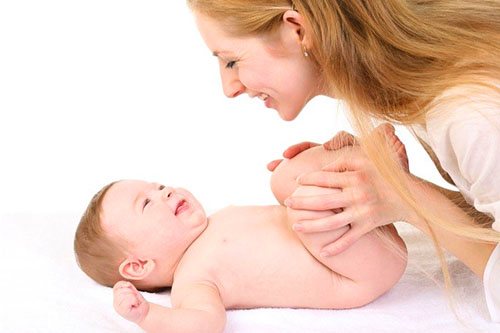
The session can only be carried out if the baby is relatively calm. If he is too capricious, then a positive effect will not be achieved. In this case, it is better to postpone the procedure to another time. During a baby massage for hypertonicity, adhere to the following recommendations:
- Before the session, it is necessary to create a comfortable atmosphere in the room. The room temperature must be maintained at 23 degrees at all times. Make sure there are no drafts. Eliminate all unpleasant odors and loud sounds.
- Prepare the area for the massage. It is best to use a special table. If it is not there, you can carry out the procedure on a changing table. Cover it with a blanket. Place an oilcloth on top and cover it with a clean, hot ironed diaper.
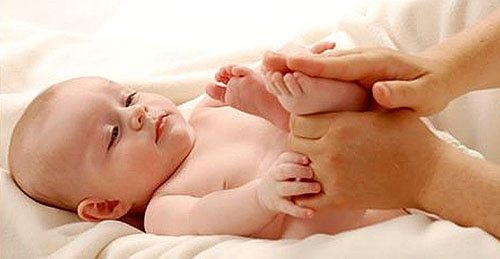
- Wash your hands thoroughly. They should not be wearing rings or bracelets. Keep your nails trimmed, as their sharp edges can hurt your baby's delicate skin.
- It is recommended to carry out the procedure on an empty stomach. Wait at least 45 minutes after feeding. You should also not feed the baby immediately after the session. Let it rest for at least an hour.
- To tone the legs of children, massage should be done on clean, dry skin. Do not use petroleum jelly, cream or powder. Give your skin the opportunity to breathe fully.
- During the procedure, make all movements in the direction from the feet to the groin area. Make sure your actions are as smooth and gentle as possible. Any too much pressure may cause injury.
If these recommendations are followed, the session will be as comfortable as possible for the baby and will benefit his health.
The duration of the session for infants should not exceed five minutes. At an older age, you need to massage your legs for ten minutes.
To successfully cure hypertension, ten sessions are enough. After six months, the course can be repeated.
Massage technique for flexor hypertonicity
Massage of the arms, legs, feet, chest, abdomen and back is performed for 1-3 minutes with light strokes (superficial, planar, ironing, rake-like).
Hand massage
Hand massage should be performed with the child lying on his back. When massaging the baby’s left hand, place the finger of the masseur’s right hand in the baby’s palm, and with the left hand grab the wrist joint and move the hand along the flexor muscles towards the shoulder.
Massage of the right hand is also done with the right hand, and with the left hand you need to support the baby’s left arm in a half-bent position. After 10 days, a rubbing technique (sawing and shading) is added to the stroking.
Foot massage
Children's foot massage is performed on the child in a supine position with the feet facing the massage therapist. With one hand you need to hold and lift the opposite leg by the foot. In this case, it should lie on the palm in a slightly bent position. Stroke with the other hand along the surface of the legs outward and backward in the direction from the foot to the groin area. After 10 days, rubbing techniques are added.
Foot massage
Foot massage should be done using the cone of the thumb, with pressure along the entire foot from the toes to the heel. At the same time, the toes will reflexively extend.
Abdominal massage
Abdominal massage should be done clockwise using two hands: the palm of the right hand performs stroking movements of the left half of the abdomen from top to bottom, the palm of the left hand strokes the right half of the abdomen from bottom to top. Repeat 6-8 times.
Breast massage
Breast massage is performed without increased finger pressure! You need to make light stroking massage movements along the intercostal spaces from the sternum to the sides. Repeat 2-4 times. Turn the child onto his stomach and perform a back massage.
Back massage
The back massage begins by stroking from the neck to the buttocks with the palms of both hands. Then with the back of the hand - from the buttocks to the head, repeating 4-8 times in each direction.
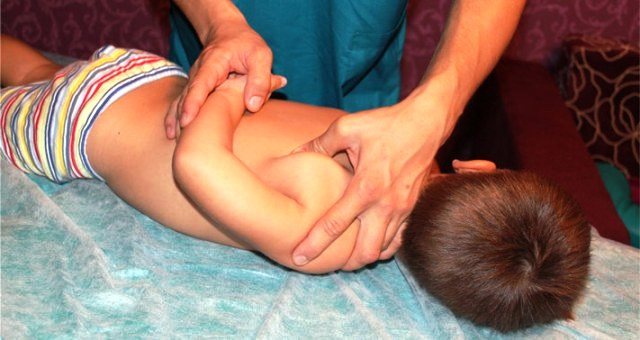
Massage for hypertension
Massage technique
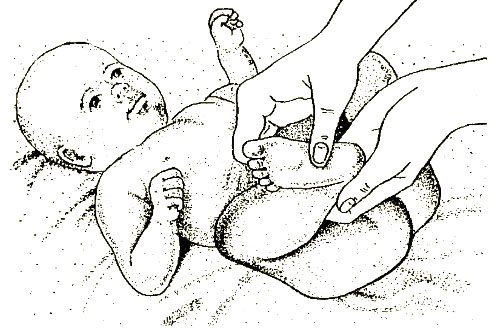
The rules for performing a massage for muscle hypertonicity in a child are quite simple. Any mother can master it. Follow the following sequence of actions:
- Carry out the procedure with warm hands. To do this, rub your palms together.
- You also need to warm up the baby's skin. To do this, gently stroke the legs with your palms.
- Exercise will help relieve general tension in the lower body. Lay your baby on his back. Place your hands under the baby's lower back. Lift your body and rock it slightly from side to side.
- Place the baby on his back. Raise one leg. Place it on your palm. With your other hand, gently stroke the entire leg from the foot to the groin area. Repeat similar steps with the other leg. Try to avoid impact on the kneecap.
- Place your baby's foot between your two palms. Using rubbing movements, go over the entire limb.
- Wrap your hand around your leg. Use vigorous pressing movements. Don't overdo it, don't push too hard.
- Shake your baby's leg with gentle, gentle movements. If hypertonicity is too pronounced, then this technique is contraindicated.

- Slightly spread your baby's legs apart. Lightly shake and flex your feet. Massage your feet. After this, stretch the muscles of your legs.
- Bend the baby's limbs so that you get a right angle. Use smooth movements with light vibration to press on the soles of your feet. Apply light pressure to the Achilles tendon.
- Flex and straighten your baby's limbs. Such actions must be repeated at least 10 times. This exercise will not only help relieve tension, but also have a beneficial effect on the functioning of the joints.
- Draw a figure eight on each child's foot. At the same time, start moving from your fingers. The crosshair of the figure eight should be located in the middle of the foot. After this, massage each finger.
- The final stage of the procedure is stroking movements over the entire surface of the foot and leg.
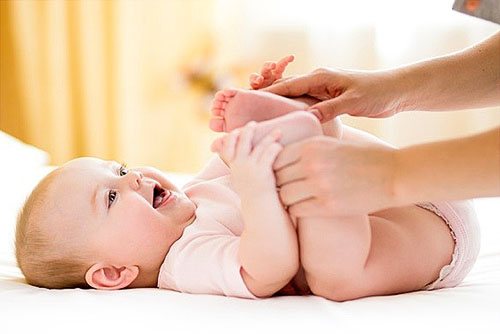
If some techniques remain unclear to you, study the video of a massage for hypertonicity of a child’s legs. This way you can better understand all the features of the procedure.
During such a massage, you should not make chopping or clapping movements. Such actions can have the opposite effect and increase muscle tension.
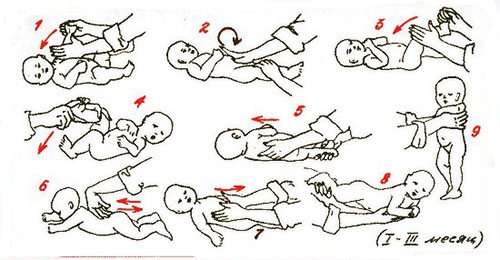
Massage is the most effective remedy in the fight against hypertension. Study the methodology for doing it. If you are not confident in your own abilities, consult a specialist.
Therapeutic massage for hypertension
Hypertonicity is usually diagnosed in children of one month of age. Only in the most severe cases do doctors prescribe drug treatment; the most common prescriptions are physiotherapy, therapeutic massage and therapeutic exercises.
The ultimate goal of all procedures is to relieve muscle tension and completely relax the muscles. It is advisable to carry out the first course of therapeutic massage with the involvement of specialists (or at least under their supervision).
Foot massage
- It starts with the child's left leg. With your left hand we hold the ankle joint, placing it between the index and middle fingers.
- At this time, we massage with our right hand, starting stroking movements from the foot. We gradually rise to the lower leg, massage the side, then the front part of the thigh. After massaging the thighs, massage the groin area for two to three minutes. Then we start all over again, from the foot. We repeat stroking the child’s feet 7-10 times.
- After stroking, we begin rubbing the same areas. Rub with fingertips, spiral and straight movements from bottom to top and vice versa.
- Then gently knead the same area by pressing.
- We massage the foot, stroking it and moving from the toes to the heel. Gently press the area of the foot under the middle finger with your index finger and move along the outer arch. Usually, this will straighten the baby’s fingers; this exercise should be repeated 5-7 times.
- We rub the child’s foot with our thumb, drawing a figure eight.
- We knead the foot with gentle pressure from the thumb.
- We stroke the outer side of the foot from the toes to the ankle with the middle and index fingers.
- We rub the same area with various movements: straight, spiral, etc.
After completing a set of exercises, we take the child’s leg with our right hand. In this case, the big toe should be on the inside of the foot (under the toes), and the rest on its outside.
With our left hand we fix the baby’s knee and bend and unbend the baby’s leg 5-6 times so that the knee and hip joints work. Children have problems with hip joints, how to deal with dysplasia with massage and gymnastics.
The child’s right leg is massaged in the same order. After you have finished massaging your legs, you need to bend them several times, holding your knees and slightly pressing on your stomach.
Then the knees need to be spread apart, while the feet should remain together. We make several smooth movements, rubbing the child’s feet against each other.
Buttocks and back massage
After massage exercises on the legs, we begin to massage the back. We turn the child onto his stomach.
Rub and knead the skin with light movements of your fingers. Then we stroke the back, starting from the neck and going down to the lower back.
We rub and knead the gluteal muscles; light pressure and pinching are recommended. Very carefully, without causing pain to the child .
Breast massage
We turn the child onto his back again and stroke his stomach with light movements in a clockwise direction.
Then we stroke the chest, from the sternum to the armpits, using light rubbing movements of the fingers. Tap the ribs very lightly with your fingers.
Hand massage
We begin the massage by rubbing, warming up and stroking the outer part of the child’s left arm. With your left hand, we fix the child’s left arm so that your thumb is clamped in the child’s fist.
With our right hand we stroke the baby's hand from top to bottom and at the same time rub it, making smooth multidirectional movements with our fingers.
The external muscles of the arms in children are weakened; they should be massaged using vibration movements and pressure.
On the contrary, the internal muscles (flexors) are tense and should be relaxed as much as possible using stroking and light rubbing movements in a circle. We repeat the same for the right hand.
Then we begin to do the following exercises:
- We spread the baby's arms to the sides, then cross them on the chest.
- We raise the handles up one by one. Then we raise both arms at the same time.
- Shake the hands separately and together.
- Rotate each handle back and forth relative to the shoulder girdle.
All these exercises should be repeated 5-7 times. The massage should take about half an hour .
It should be done once a day or several times a day, but at a lower intensity (7-10 minutes).
Next, we recommend that you watch a video about how massage is done for muscle hypertonicity in a child.





